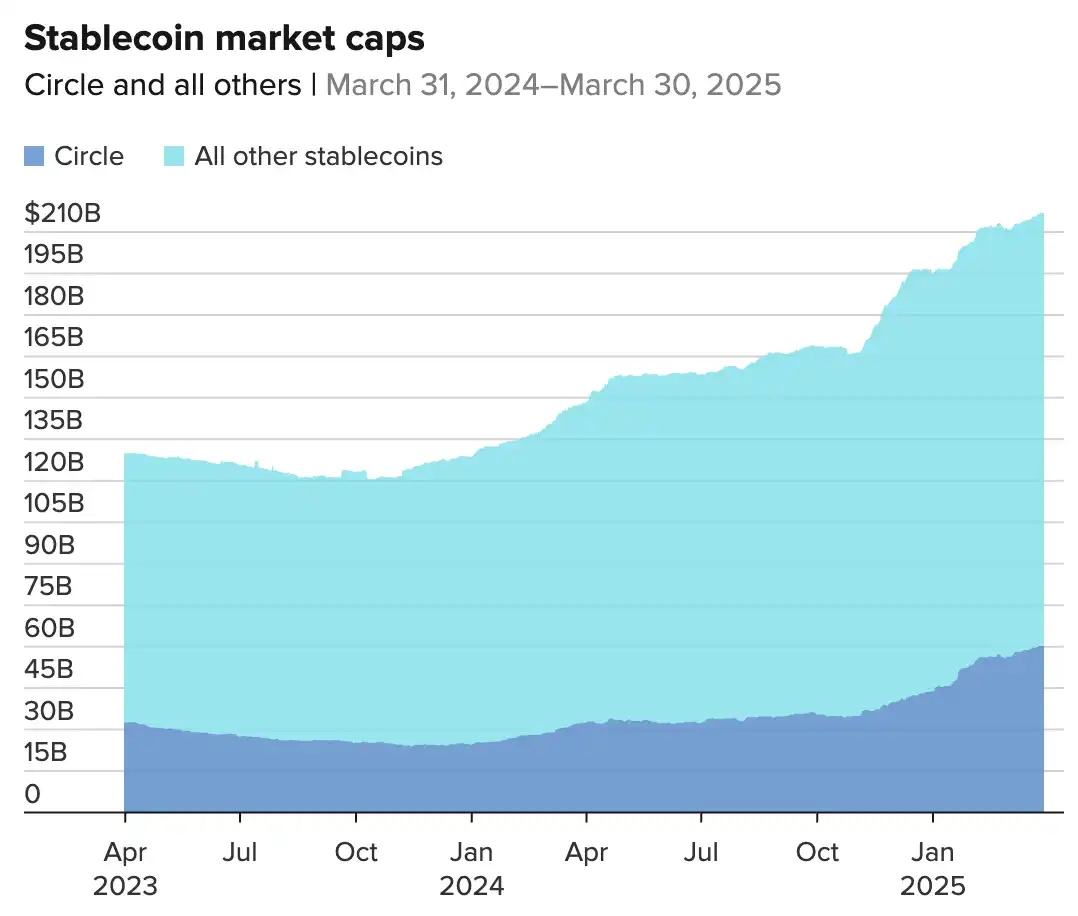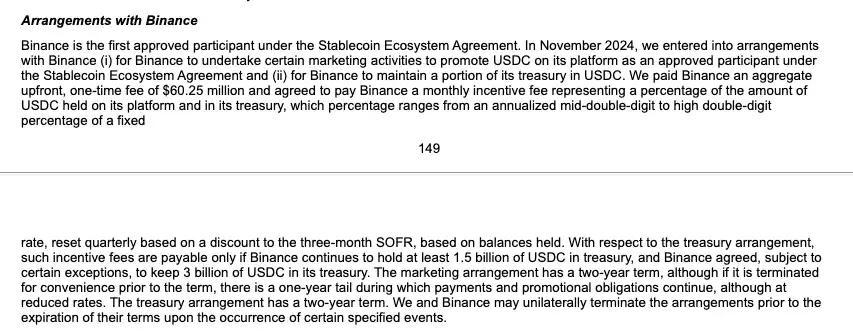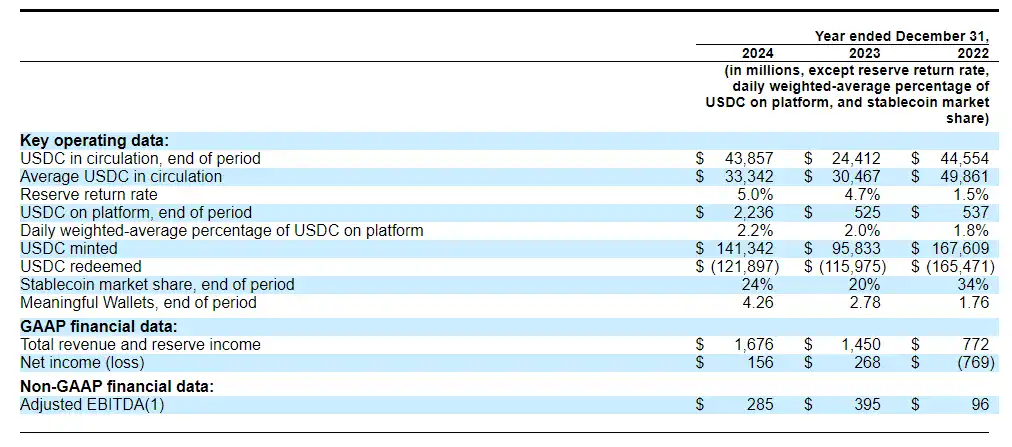The global second-largest stablecoin USDC's issuer Circle has officially launched its listing plan, preparing to go public on the New York Stock Exchange. On April 2, the company submitted its prospectus to the SEC, taking the long-awaited first step towards its IPO. The S-1 filing does not specify a timeline for the IPO, but typically companies can begin trading within weeks after submitting the S-1. According to the S-1 prospectus, JPMorgan and Citigroup will act as lead underwriters, and the market expects Circle's valuation could reach $5 billion, with the stock ticker symbol "CRCL." The prospectus indicates that Circle will issue an unspecified number of Class A common shares, while existing shareholders will also register to sell part of their holdings. The pricing range per share has not yet been determined. The proceeds from the sale of shares will belong to Circle, while the proceeds from existing shareholders' sales will not be included in the company.
This is Circle's second attempt to go public. At the end of 2022, it tried to enter the capital market through a merger with a SPAC (Special Purpose Acquisition Company), but it ultimately fell through due to regulatory issues, resulting in a loss of over $44 million. Subsequently, Circle adjusted its strategy and gradually moved closer to financial centers. Last year, it relocated its headquarters from Boston to One World Trade Center in New York, further integrating into the global financial core.
This time, Circle has chosen a delicate timing—technology stocks have recently experienced significant volatility, and the Nasdaq index has just gone through its worst quarter since 2022. If the IPO is successful, Circle will become another heavyweight cryptocurrency company listed on a mainstream U.S. exchange after Coinbase, and also the first stablecoin company to go public.
Sustained Pressure on Profits in the Ecological Closed Loop
Circle's story began in 2013 when it positioned itself as a company focused on Bitcoin-related businesses, aiming to make digital currency usage more convenient through technology. As the cryptocurrency market evolved, Circle seized a new opportunity in 2018—partnering with Coinbase to launch the dollar stablecoin USDC through the Centre alliance. USDC is a digital asset pegged 1:1 to the U.S. dollar, designed to provide stability and credibility for cryptocurrency transactions.
In 2023, the Centre alliance was dissolved, and Circle gained full control of USDC. From then on, USDC was no longer just a collaborative project but became Circle's core asset. By 2025, USDC's market capitalization had reached $60.1 billion, although it still lagged behind Tether's USDT (market cap $144.4 billion), its growth momentum and transparency allowed it to secure a place in the market.
USDC is Circle's most well-known product and is the second-largest stablecoin globally. USDC rapidly rose during the last cryptocurrency bull market, with its market cap soaring from less than $1 billion in 2020 to over $50 billion in 2022, and further growing to $60.1 billion in 2024, accounting for 26% of the entire stablecoin market. Although the leading Tether (USDT) still holds a dominant 67% market share, USDC has seen rapid growth this year—its market cap increased by 36%, while Tether only grew by 5%.

Data Source: CryptoQuant
Related Reading: "Circle IPO Rush for $5 Billion Valuation, Is There a Concept Stock for Stablecoins?"
High Distribution Costs and Declining Gross Margins
Circle understands that the success of USDC relies on ecological support. Initially, it issued USDC in collaboration with Coinbase through the Centre alliance, but after the alliance dissolved in 2023, Circle took full control. The S-1 reveals that Coinbase now holds a minority stake in Circle, and the two parties distribute profits more evenly based on total reserve income (still divided according to the amount of USDC held in their respective wallets and custody products). Circle earned approximately $1.7 billion in revenue in 2024 and paid over $900 million to Coinbase as a distribution partner.

In December 2023, Circle also partnered with Binance, the world's largest cryptocurrency exchange, paying a one-time fee of $60.25 million and a monthly fee based on a certain percentage, allowing USDC to participate in Binance Launchpool, which increased USDC supply on the Binance platform from less than $1 billion to $4 billion.

This "buying growth" strategy significantly increased USDC's circulation and market recognition but also raised operational costs. Circle has built a strong distribution network through partnerships with giants like Coinbase, Binance, and BlackRock, ensuring USDC's penetration in the global cryptocurrency ecosystem.
Institutional Relationship Network as a Major Moat
Circle's business model can be described as "stablecoin + ecological expansion." It is not only a stablecoin issuer but also attempts to create an ecosystem covering cryptocurrency payments, cross-chain technology, and enterprise solutions through a series of products and services.
The issuance and circulation of USDC are Circle's core business and its most important source of revenue. For every USDC issued, Circle deposits an equivalent amount of U.S. dollars or highly liquid assets as reserves in the bank to ensure its value stability. Users can use USDC for transactions, payments, or savings, while Circle earns income by managing these reserve assets. To expand USDC's circulation, Circle has established deep collaborations with financial and cryptocurrency giants like Coinbase, Binance, and BlackRock. For example, in the agreement with Coinbase, Circle sets the payment base according to the daily net income of USDC reserves, and after deducting management fees, both parties share the profits proportionally. As of 2024, USDC's circulation continues to grow, especially in the DeFi and cross-border payment sectors.
In terms of payment and enterprise services, Circle acts as a bridge connecting the cryptocurrency world with traditional business. It provides a complete set of payment APIs and enterprise-level tools, enabling merchants to easily accept USDC payments and automatically convert them into fiat currency. This service model is similar to PayPal in traditional finance but optimized for the crypto economy. For instance, e-commerce platforms can integrate Circle's Checkout service, allowing consumers to pay with USDC, after which Circle will convert the cryptocurrency into U.S. dollars in real-time and settle with the merchant, significantly lowering the barriers for businesses to engage in cryptocurrency payments.
Cross-chain technology and blockchain infrastructure are another key barrier Circle has built. The cross-chain bridge developed by the company allows USDC to flow freely between different blockchains like Ethereum and Solana, greatly enhancing the stablecoin's usability. Additionally, the prospectus reveals that Circle is developing Layer 2 solutions aimed at reducing transaction costs and improving efficiency, laying out plans for cryptocurrency infrastructure.
To reach end users more directly, Circle has also launched a digital wallet service. Although currently limited in scale, it is evident that the business is extending from B2B to B2C.
In summary, Circle's business model resembles a "stablecoin-driven ecological closed loop": centered around USDC, it extends the potential of cryptocurrency into the real world through payments, technology, and user services. Its ambitions are significant, covering almost all areas of cryptocurrency outside of CEX.
Where Did Last Year's $1.68 Billion Revenue Come From?
According to the prospectus, the financial data disclosed this time presents a complete picture of Circle's performance in recent years.
For the fiscal year 2023 (ending December 31), total revenue and reserve income reached $1.68 billion, a year-on-year increase of 16%, continuing to grow from $1.45 billion in 2022 and $772 million in 2021. Revenue in 2024 mainly comes from interest income on reserve assets supporting USDC.
In 2024, total operating expenses are projected to be $491.7 million, with payroll expenses ($263.4 million), administrative expenses ($137.3 million), and IT infrastructure investments ($27.1 million) making up the majority. The net profit from continuing operations is $156.9 million, although lower than $271.5 million in 2023, it shows significant improvement compared to a loss of $761.8 million in 2022. The adjusted EBITDA for 2024 is $284.9 million.
The company also recorded a $4.3 million impairment loss on digital assets that year, while earning $54.4 million in other income from non-core business revenues. The prospectus has not yet finalized the weighted average number of shares outstanding and earnings per share data.
According to the plan, Circle intends to use the funds raised from the IPO for product development, working capital, scaling expansion, and potential acquisitions, among other routine corporate purposes. Specific pricing timelines and share allocation plans have not yet been disclosed.
Operational and Financial Metrics
Circle earns money by managing the reserve assets of USDC. These reserves include cash and short-term U.S. Treasury bonds, generating substantial interest income in a high-interest-rate environment. The S-1 shows that Circle's total revenue for 2024 is $1.68 billion, of which 99% (approximately $1.665 billion) comes from reserve income, while other sources (such as payment services and cross-chain technology) contribute only $15 million. This means Circle relies almost entirely on a single source of income, which is affected by government interest rate policies. The document estimates that if interest rates decrease by 1%, reserve income would drop by $441 million. However, Circle believes that low interest rates may stimulate the growth of USDC circulation, but this relationship is "complex, uncertain, and unproven."
As of December 31, 2024, USDC has been used in approximately $20 trillion of on-chain transactions. The table below lists key operational and financial metrics during the specified period, along with relevant GAAP (Generally Accepted Accounting Principles) measures:

The circulation and average circulation of USDC are the main contributors to Circle's reserve income and serve as indicators of the breadth of Circle's stablecoin ecosystem. As of December 31, 2024, December 31, 2023, and December 31, 2022, the USDC held by the company was $294.5 million, $275.8 million, and $5.3 million, respectively.
The Reserve Return Rate refers to the return rate generated by reserve assets and is a primary determinant of reserve income, calculated as reserve income divided by the average period balance of reserves exclusive to Circle stablecoin holders. As of December 31, 2024, December 31, 2023, and December 31, 2022, the company's reserve return rates were 5.0%, 4.7%, and 1.5%, respectively.
Stablecoin Market Share refers to the proportion of circulating Circle stablecoins relative to the total circulation of all fiat-backed stablecoins (i.e., digital assets pegged to the value of fiat currency). This metric reflects the share of Circle stablecoins in the overall stablecoin market and its position in the competitive landscape. Since 2021, Circle has been the second-largest stablecoin issuer globally by circulation. According to CoinMarketCap data, as of December 31, 2024, Circle's stablecoin market share was 24%.
Meaningful Wallets refer to the number of digital asset wallets with an on-chain USDC balance exceeding $10, serving as an important metric for measuring the breadth of USDC adoption. In 2024, the number of meaningful wallets was 4.26 million, an increase of 53.24% compared to the end of 2023.
Profit Breakdown
The table below shows Circle's profit and loss statement for 2024, detailing the company's revenue, expenses, and net profit metrics for the year:

As of December 31, 2024, reserve income was $1.676 billion, an increase of $230.5 million (16.1%) compared to 2023. Of this, approximately $139.9 million of the growth came from the increase in the average daily balance of circulating USDC, reflecting increased demand for USDC associated with digital asset trading activities and Circle's market share growth in key markets; $89.9 million of the growth came from an increase in average yield, primarily influenced by the Federal Reserve's interest rate hikes. Other income for 2024 decreased by $4.7 million (23.6%) year-on-year, mainly due to a $3.9 million decline in trading service income, which was related to the gradual discontinuation of certain services in 2024.
In 2024, distribution and trading costs increased by $291 million (40.4%) compared to the end of 2023, primarily due to an increase of $216.6 million in distribution costs paid to Coinbase and an increase of $74.1 million in other distribution incentive costs related to new strategic distribution partnerships, such as the one-time upfront fee paid to Binance. Other expenses for 2024 decreased by $1.4 million (17.2%) compared to 2023, mainly due to the company's discontinuation of traditional trading service products, which reduced related expenses by $900,000.
The annual profit for 2024 was $156 million, a decrease of $112 million compared to the net income for 2023. Although reserve income for 2024 increased by $230.5 million compared to 2023, distribution and trading costs also significantly increased by $291 million compared to the end of 2023, with total operating expenses rising by $39 million, ultimately leading to a decline in profit.
In terms of cash flow, from 2022 to 2024, the USDC reserve cash balance held in bank accounts far exceeded the $250,000 FDIC insurance limit per financial institution. As of December 31, 2024, approximately 85% of USDC reserves were held in the Circle Reserve Fund, with the remainder held in cash across several bank accounts. The Circle Reserve Fund is managed by BlackRock. This fund is exclusively available to Circle, and Circle is the sole shareholder of the Circle Reserve Fund.

In terms of financing, the funds raised in 2024 amounted to $19.4499 billion, while the funds raised in 2023 were -$20.3222 billion, primarily due to the increase in circulating USDC in 2024, which led to a net change in stablecoin holders' deposits increasing by $19.4521 billion; whereas in 2023, the decrease in circulating USDC resulted in a net change in stablecoin holders' deposits decreasing by $20.3222 billion.
High compensation costs have raised questions, with executives being the real winners of the IPO?
Circle's IPO is not only about the company's future but also a capital feast. After Circle goes public, it will implement a three-tiered equity structure: Class A shares issued in the IPO will have one vote per share; Class B shares held by co-founders Jeremy Allaire and Patrick Sean Neville will have five votes per share, but total voting rights will not exceed 30%; Class C shares will have no voting rights but can be converted under specific conditions. Class B shares will automatically convert to Class A shares when transferred through non-permitted channels.
Additionally, according to the prospectus, executive compensation includes CEO Jeremy Allaire's annual salary of $900,000, stock awards of $9 million, plus $2 million in benefits, totaling over $12 million. Chief Financial Officer Jeremy Fox-Geen has a total compensation of $5.2 million ($500,000 salary + $4 million in stock + $700,000 in benefits). Other executives, such as Chief Strategy Officer Elisabeth Carpenter, President and Chief Legal Officer Heath Tarbert, and Chief Product and Technology Officer Nikhil Chandhok, have annual salaries ranging from $4 million to $5 million. Working at Circle clearly comes with substantial rewards.
For venture capital giants, investors holding more than 5% of shares will make a significant profit, including General Catalyst (the largest corporate shareholder), Beijing IDG Capital, Breyer Capital, Accel, Oak Investment Partners, and Fidelity. These institutions collectively hold over 130 million shares, and an IPO valued at $4 billion to $5 billion will bring them considerable returns.
The market capitalization of USDC has doubled in the past year, increasing from about $30 billion to $60 billion, but market competition is becoming increasingly fierce. The main competitor, Tether (USDT), leads with a market capitalization of over $140 billion. Additionally, PayPal launched its own stablecoin in 2023, and banking giants like JPMorgan are also exploring the blockchain space. In the S-1 filing, Circle listed these competitors and acknowledged the complex market environment.
Despite this, Circle remains optimistic about the future. The legislative process for stablecoins in the U.S. is accelerating, with the "GENIUS Act" and "STABLE Act" drawing significant attention. Bryan Steil, chairman of the House Digital Assets Subcommittee, stated that after the review on April 2, the two bills are expected to reach consensus after revisions and are planned to be submitted to the president for signature within the first 100 days of the Trump administration. This progress provides policy benefits for compliant stablecoin companies like Circle and marks a clearer regulatory framework for the U.S. in the digital dollar space.
This IPO still needs to pass regulatory scrutiny and proceed based on market conditions, with specific details on the issuance scale and per-share valuation to be disclosed in supplementary documents before the listing. Although uncertainties remain, Circle's IPO is likely to become a key signal for the future direction of the stablecoin industry. As global regulatory policies become increasingly clear, stablecoins are moving towards an era of compliance and deep institutional participation. Can Circle seize this opportunity and leverage the abundant capital flow from Wall Street to challenge Tether's long-held throne? Amid multiple challenges of regulation, competition, and market volatility, can Circle meet market expectations? All of this will take time to prove.
免责声明:本文章仅代表作者个人观点,不代表本平台的立场和观点。本文章仅供信息分享,不构成对任何人的任何投资建议。用户与作者之间的任何争议,与本平台无关。如网页中刊载的文章或图片涉及侵权,请提供相关的权利证明和身份证明发送邮件到support@aicoin.com,本平台相关工作人员将会进行核查。




